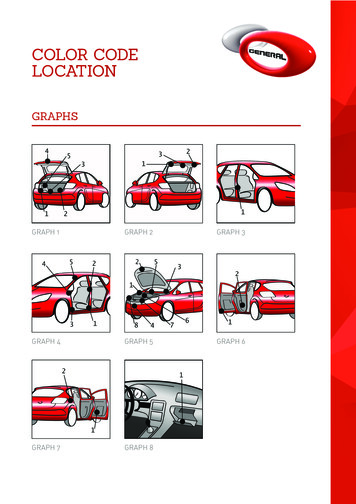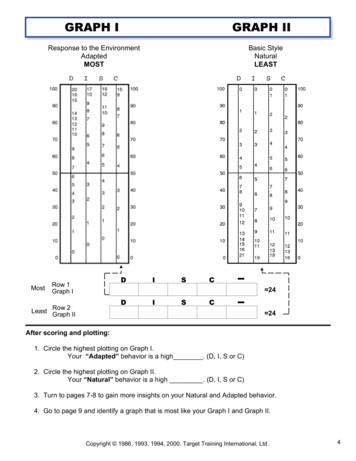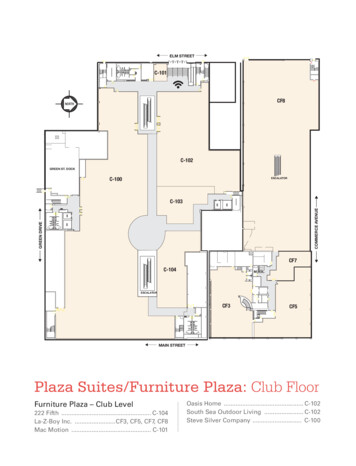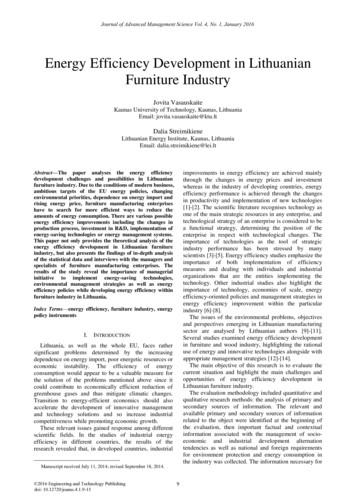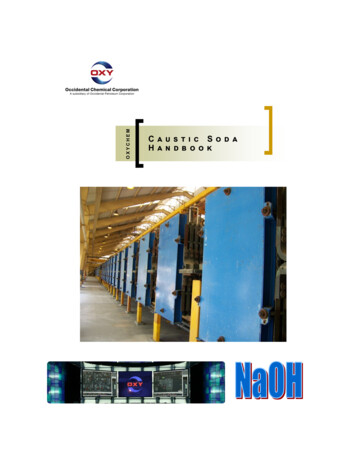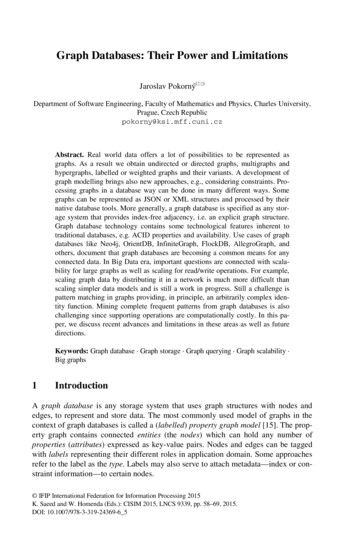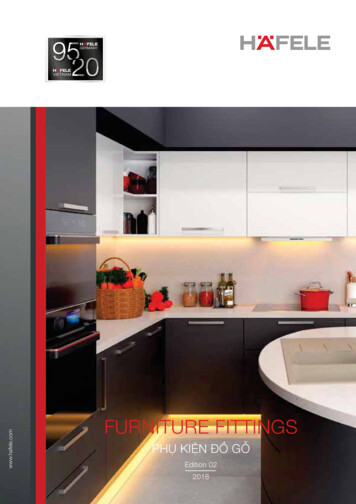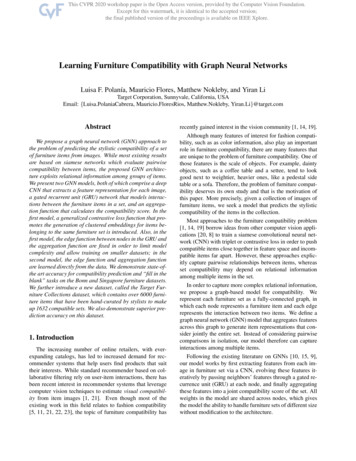
Transcription
Learning Furniture Compatibility with Graph Neural NetworksLuisa F. Polanı́a, Mauricio Flores, Matthew Nokleby, and Yiran LiTarget Corporation, Sunnyvale, California, USAEmail: {Luisa.PolaniaCabrera, Mauricio.FloresRios, Matthew.Nokleby, Yiran.Li}@target.comAbstractWe propose a graph neural network (GNN) approach tothe problem of predicting the stylistic compatibility of a setof furniture items from images. While most existing resultsare based on siamese networks which evaluate pairwisecompatibility between items, the proposed GNN architecture exploits relational information among groups of items.We present two GNN models, both of which comprise a deepCNN that extracts a feature representation for each image,a gated recurrent unit (GRU) network that models interactions between the furniture items in a set, and an aggregation function that calculates the compatibility score. In thefirst model, a generalized contrastive loss function that promotes the generation of clustered embeddings for items belonging to the same furniture set is introduced. Also, in thefirst model, the edge function between nodes in the GRU andthe aggregation function are fixed in order to limit modelcomplexity and allow training on smaller datasets; in thesecond model, the edge function and aggregation functionare learned directly from the data. We demonstrate state-ofthe art accuracy for compatibility prediction and “fill in theblank” tasks on the Bonn and Singapore furniture datasets.We further introduce a new dataset, called the Target Furniture Collections dataset, which contains over 6000 furniture items that have been hand-curated by stylists to makeup 1632 compatible sets. We also demonstrate superior prediction accuracy on this dataset.1. IntroductionThe increasing number of online retailers, with everexpanding catalogs, has led to increased demand for recommender systems that help users find products that suittheir interests. While standard recommender based on collaborative filtering rely on user-item interactions, there hasbeen recent interest in recommender systems that leveragecomputer vision techniques to estimate visual compatibility from item images [1, 21]. Even though most of theexisting work in this field relates to fashion compatibility[5, 11, 21, 22, 23], the topic of furniture compatibility hasrecently gained interest in the vision community [1, 14, 19].Although many features of interest for fashion compatibility, such as as color information, also play an importantrole in furniture compatibility, there are many features thatare unique to the problem of furniture compatibility. One ofthose features is the scale of objects. For example, daintyobjects, such as a coffee table and a settee, tend to lookgood next to weightier, heavier ones, like a pedestal sidetable or a sofa. Therefore, the problem of furniture compatibility deserves its own study and that is the motivation ofthis paper. More precisely, given a collection of images offurniture items, we seek a model that predicts the stylisticcompatibility of the items in the collection.Most approaches to the furniture compatibility problem[1, 14, 19] borrow ideas from other computer vision applications [20, 8] to train a siamese convolutional neural network (CNN) with triplet or contrastive loss in order to pushcompatible items close together in feature space and incompatible items far apart. However, these approaches explicitly capture pairwise relationships between items, whereasset compatibility may depend on relational informationamong multiple items in the set.In order to capture more complex relational information,we propose a graph-based model for compatibility. Werepresent each furniture set as a fully-connected graph, inwhich each node represents a furniture item and each edgerepresents the interaction between two items. We define agraph neural network (GNN) model that aggregates featuresacross this graph to generate item representations that consider jointly the entire set. Instead of considering pairwisecomparisons in isolation, our model therefore can captureinteractions among multiple items.Following the existing literature on GNNs [10, 15, 9],our model works by first extracting features from each image in furniture set via a CNN, evolving these features iteratively by passing neighbors’ features through a gated recurrence unit (GRU) at each node, and finally aggregatingthese features into a joint compatibility score of the set. Allweights in the model are shared across nodes, which givesthe model the ability to handle furniture sets of different sizewithout modification to the architecture.
We present two GNN models. In the first, we extend thesiamese model to multiple inputs and branches via the GNNarchitecture. In particular, we generalize the contrastive lossto an arbitrary number of items. Instead of minimizing thedistance between positive pairs and maximizing the difference between negative pairs, we minimize the distance between each item and the centroid of its furniture set for thecase of compatible sets and maximize the distance to thecentroid for the case of incompatible sets. We train the endto-end network, including the CNN and GRU parametersvia this generalized loss. This encourages a compatible setto have features that are close together, and different sets,which are presumable not compatible, to have features farapart. The compatibility score of a proposed furniture setis calculated by taking the average distance of item embeddings to their centroid.In the second model, we draw inspiration from graph attention networks [25], which learn scalar weights betweenconnected nodes in order to capture richer notions of graphstructure. We allow the edge function, which dictates hownodes aggregate neighboring features before putting theminto the GRU, to be learned directly from the data insteadof fixed in advance. Further, instead of using the distance tothe centroid to measure compatibility, we learn a function—in the form of a fully-connected network—that maps GNNfeatures to a compatibility score. This choice is motivatedby deep metric learning approaches [13, 27], which compared to linear transformations, such as the Euclidean orMahalanobis distance, are better at capturing the nonlinearmanifold where images usually lie on. Because this secondmodel has more parameters to train from data, it requireslarger datasets to train, whereas the first model is suitablefor smaller datasets.We demonstrate the utility of our approach by establishing new state-of-the-art performance for furniture compatibility. We perform experiments on the Bonn [1] and Singapore datasets [13] and show superior performance on thetasks of predicting compatibility of furniture sets and ”filling in the blank” of partial furniture sets. One challengewith these datasets is that they encode style informationonly via coarse style categories—every item in the style category is considered to be compatible, which may not correspond to real-world notions of compatibility.To address this issue, we also introduce a new dataset,which we term the Target Furniture Collections dataset.This dataset contains over 6000 items that have been organized into 1632 compatible furniture sets. These setshave been chosen by professional furniture stylists, and theyencode a richer sense of style compatibility than existingdatasets. Instead of supposing that items are compatiblebecause they share the same style attribute, with the Target Furniture Collections dataset we suppose that items arecompatible because a stylist has put them in the same set.We also show that our GNN model outperforms existingmethods on the Target Furniture Collections dataset.The main contributions of this work are summarizedas follows: (1) We propose the first furniture compatibility method that uses GNNs, which leverages the relational information between items in a furniture set. (2)Two GNN models are proposed. We propose a generalized contrastive loss function to train the first model,which extends the concept of the siamese network to multiple branches. The second model differs from the firstmodel in that it learns both the edge function and the aggregation function that generates the compatibility score,unlike traditional GNN approaches which use predefinedfunctions. (3) We introduce a new furniture compatibility dataset (available at tions-dataset/v/1).2. Related WorkThe past five years have seen substantial interest in addressing the problems of visual compatibility and style classification for both furniture and fashion. In this section, weprovide an overview of prior work, and emphasize the mainnovelties of our work when compared to prior efforts.Many authors have framed the problem of visual/stylecompatibility as a metric learning problem, for instance[12, 18, 21] for fashion, as well as [1, 2] for furniture. Forexample, the model in [21] consists of two sub-networks,the first sub-network is a siamese network which extractsfeature for the input pair of images, while the second subnetwork is a deep metric learning network. The wholemodel is trained end-to-end in order to derive a notionof compatibility between a pair of items. However, suchmodel fails at modeling the complex relations among multiple items. The outfit generation process has been modeled as a sequential process through bidirectional LSTMs in[11]. However, the assumption of a sequence fails at properly modeling either an outfit or a furniture set, where theconcept of a fixed order of items does not exist.Foundational work in GNNs, such as [7, 24], paved theway for a number of applications and breakthroughs in recent years, such as the development of graph convolutionalnetworks or graph attention networks in [26], to name afew. Two GNN approaches have been proposed for fashion, [4] and [3]. The first one creates a fashion graph withnodes corresponding to broad categories (e.g. pants), whilecompatible outfits are directed subgraphs, while the seconddeveloped a context-aware model, to account for personalpreference and current trends. Since this paper is focusedon furniture compatibility, comparisons are performed onlywith previously proposed visual compatibility algorithmsfor furniture.Until recently, the problem of furniture compatibility hasreceived less attention, and to the best of our knowledge,
GNN models have not been developed. The authors of [1]addressed the task of style compatibility and style classification among 17 categories using a Siamese network, andalso proposed a joint image-text embedding method. Meanwhile, the authors of [14] address the style classificationproblem by creating handcrafted features using standardfeature extractors, such as SIFT and HOG, and then applying an SVM classifier. On a related but somewhat differentline of work, [16, 17, 19] have devised models to predictthe style compatibility of computer-generated 3D furnituremodels.Prior work using Siamese network approaches suffersfrom an inability to measure similarity in collections thatconsist of more than two items. While one could assemble collections of multiple items by aggregating pairwisecompatibility scores, such approach disregards the complexstylistic interactions that different items may have. Meanwhile, sequential generation artificially introduces a notionof time dependence into the model.3. Proposed MethodGiven a furniture set, we aim at predicting the compatibility score of the set. To achieve this goal, we propose torepresent a furniture set as a graph, where each node represents an item and each edge represents interaction betweentwo items.The GNN model can be decomposed into three majorsteps. The first step learns the initial node representation.The second step models node interactions and updates thehidden state of the nodes by propagating information fromthe neighbors. The third step calculates the compatibilityscore. A schematic overview of the GNN model is shownin Figure 1.In this paper, we consider two variants of the GNNmodel, referred to as Model I and Model II, which differ in how the compatibility score is calculated and in thedefinition of the edge function. In Model I, the compatibility score is determined by the average distance betweenthe node states and their centroid and the edge function ispredefined. Contrarily, in Model II, the node states are aggregated and further processed to generate the compatibility score and the edge function is learned during training.Those modifications lead to model capacity gains at the expense of increasing the memory and computational cost.3.1. Model IModel I can be thought of as a generalization of thesiamese model to multiple inputs, with the additional advantage of allowing exchange of information between inputs. Such generalization requires the definition of a newloss function, which extends the idea of mapping item pairsclose to each other in the feature space to the entire set. Adetailed description of Model I is provided in this section.3.1.1Network ArchitectureLet S {I0 , I1 , . . . , IN 1 } be the images of the items belonging to an arbitrary furniture set. These images are firstmapped to a latent semantic space with a convolutional neural network. This operation is represented ash0i ψ(Ii ), i 0, . . . , N 1,(1)where h0i RL and ψ denote the L-dimensional initial hidden state of node i and the feature extractor operator, e.g.AlexNet, respectively. Note that the number of items Nmay vary across different furniture sets, and therefore, eachfurniture set has its own graph morphology.Since the goal is to learn compatibility, the feature representation of an item should also contain information aboutthe items it is compatible with. This is accomplished by iteratively updating the node hidden states with informationfrom the neighbor nodes using a gated recurrent unit (GRU).That is, at every time step k, a GRU takes the previous hidden state of the node hik 1 and a message mki as input andoutputs a new hidden state hki .The message mki RM is the result of aggregating themessages from the node neighbors, and is defined by theaggregation function φ(·) asmki φ({hkq q, q 6 i)})(2)X1ReLU(Wm (hkq k ekqi ) bm ), (3)N 1q,q6 iwhere Wm RM (L J) and bm RM are trainable parameters of the model and ekqi RJ is the edge featurebetween nodes q and i, which is calculated with the edgefunction υ(·) as ekqi υ(hkq , hki ). Note that the neighborsare all the other nodes since the graph is complete.Model I uses the absolute difference function as the edgefunction, which is defined as υ(hkq , hki ) hkq hki , where · denotes element-wise absolute value. Note that the absolute difference function is symmetric, i.e. υ(hkq , hki ) υ(hki , hkq ). The motivation for the choice of the absolutedifference function is that it provides information about thedistance between two connecting nodes.After K GRU steps, the compatibility score generationKlayer, takes the hidden states hK0 , . . . , hN 1 as input, applies batch normalization, averages their distance to the centroid c, and passes the average through a sigmoid function,which maps onto the interval [0, 1] to generate the compatibility score. More formally, the compatibility score s iscalculated as!N1 X K2(4)kh ck2 ,s σN i 1 iwhere σ(·) denotes the sigmoid function.
Figure 1. Schematic of the GNN model. CNNs are first used to get the initial feature representation of the nodes and GRUs are used toupdate the state of the nodes during K iterations. The hidden states are then aggregated to generate the compatibility score.3.1.2Loss FunctionThe contrastive loss has been extensively used in the contextof siamese networks for learning an embedded feature spacewhere similar pairs are closer to each other and dissimilarpairs are distant from each other. However, one limitation ofthe contrastive loss is that it is based only on feature pairs.We propose a generalized version of the contrastive loss thatpromotes the item embeddings of a compatible furniture setto cluster tightly together while the item embeddings of anincompatible furniture set are pushed away from their corresponding centroid. Let c denote the centroid of the hidden states of the nodes at step K, then the generalized contrastive loss for a training instance takes the formL di N 1 Xyd2i (1 y)max(0, m2 d2i )N i 1khKi ck2 ,υ(hki , hkj ) ReLU(We (hki k hkj ) be ),(5)where y {0, 1} is the label with 1 and 0 denoting a compatible and an incompatible furniture set, respectively. Thefirst term of the loss function penalizes compatible furniture sets whose node representations are not tightly clustered around their centroid while the second term penalizesincompatible furniture sets whose node representations arecloser than a margin m from their centroid.3.2. Model IIIn Model II, the edge function and the aggregation function that generates the compatibility score are learned instead of predefined. Details of Model II are described inthis section.3.2.1initial feature representation of the nodes, and GRUs areused to update the state of the nodes during K iterations,Kwhich results in hK0 , . . . , hN 1 hidden states.Additional steps are added to the network in order togenerate the compatibilityscore. First, the hidden statesPNare averaged, 1/N i 1 hK 1, and then passed through aia multilayer perceptron (MLP) with ReLU activation andwith parameters Θ(0) , . . . , Θ(Q 1) , where Θ(i) are the parameters of the ith layer and Q is the number of layers. Thelast layer outputs the compatibility score s, which is normalized in the range [0, 1] through a sigmoid function.In Model II, the parameters that define the edge functionare learned. That is, the edge function connecting node hiwith node hj is defined asNetwork ArchitectureAll the stages before the compatibility score generation arethe same as in Model I. That is, CNNs are used to get the(6)where We RJ 2L and be RJ are parameters of themodel. Note that unlike traditional graph attention networks[25], which only learn scalar weights between connectednodes, the proposed approach learns the edge function.The binary cross-entropy loss is used as the loss functionfor training Model II.4. ExperimentsHere we detail the datasets used for training and testingour model, describe the experimental settings, and comparethe performance of our proposed method to the state of theart.4.1. Furniture DatasetsOur experiments make use of three datasets, the BonnFurniture Styles Dataset [1], the Singapore dataset [14], aswell as the Target Furniture Collections dataset obtainedfrom the Target product catalog.
Figure 2. Side by side comparison between the Bonn Furniture dataset (left figures), and the Singapore Furniture dataset (right figures).(a) For Bonn, we see a Victorian style (top) vs. a Modern style (bottom). (b) For the Singapore set, we see a Gothic style (top) vs. aModernist style (bottom). The Singapore dataset is generally harder to learn from, as images have a mixture between solid-white, realisticand non-realistic backgrounds.side comparison of styles. The authors of [1] made thedataset available for research and commercial purposes.4.2.2Figure 3. Sample collection from the Target Furniture Collectionsdataset. The furniture pieces match not only in style, but also color,material and overall appearance.4.2. Singapore Furniture DatasetThe Singapore Furniture Dataset is the first furnituredataset specifically for furniture style analysis [14]. It contains approximately 3000 images, which are collected fromonline search tools (Google), social media (Flickr) and theImageNet dataset. Images are divided into 6 categories:bed(263), cabinet (569), chair (529), couch (391), table(429), and others (774). We adopt the first five categories forconsistency within each class. Each image belongs to oneof the 16 classes of furniture styles such as American style,Baroque style, etc, and each style contains at least 130 images. Note that some images in this dataset have non-whitebackground and are gathered under realistic scenes. Thisintroduces noises and brings some difficulty in accuratelylearning and predicting furniture styles.4.2.1Bonn Furniture Styles DatasetThe Bonn Furniture Styles Dataset consists of approximately 90, 000 furniture images, obtained from the website Houzz.com, which specializes on furniture and interior design. The images span the six most common furniture categories in the website, namely lamps (32403), chairs(22247), dressers (16885), tables (8183), beds (6594) andsofas (4080). Each image presents the item in a white background and is labelled with one of 17 styles, such as modern, mid-century or Victorian. See Figure 2 for a side-by-Target Furniture Collections DatasetThe Target Furniture Collections dataset contains approximately 6550 furniture images. The images span a widevariety of categories, including 1607 tables, 702 chairs, 406dressers, 410 beds, 350 sofas, 233 nightstands, 220 stools,154 benches and over 10 other categories (such as desks,headboards, drawers, cabinets and mirrors) with a smallernumber of items. These items have been arranged into 1632compatible collections by home décor specialists. Thesecollections vary in size, from 2 up to 20 items (though 97%of collections contain 8 items or less). While most collections are complementary in nature, we allow our definitionof collection to include any number of compatible itemseven if a category appears more than once. For example,an office-style collection may include 20 slightly differentoffice chairs. The dataset is released with a default resolution of 400 400 pixels.While this dataset is smaller in size compared to theBonn dataset, we contend that this dataset provides a richernotion of overall compatibility among furniture sets. Whilethe Bonn dataset classifies furniture pieces across multiplestyles, the fact that two items have the same style does notnecessarily imply compatibility. The Target Furniture Collections dataset assembles furniture pieces into sets that arecompatible not only in style, but also in color, and oftentimes material and texture as well.4.3. Compatibility Prediction TaskFor this task, we use our GNN model to predict whethera set of furniture items are compatible. For the Bonn Furniture dataset, we suppose a set of items are compatible if andonly if they have the same style attribute, e.g. all “baroque”items are compatible, and all “baroque” items are incompatible with all “modernist” items. For the Target FurnitureCollections dataset, we suppose that two items are com-
patible if and only if they belong to the same set. We acknowledge that these assumptions artificially limit the definition of compatible—furniture items across style types orsets may well go well together. However, these assumptions provide unambiguous definitions of compatibility, andwe maintain that success according to these definitions indicates the extent to which a recommendation model haslearned meaningful style attributes.For each test set, we compute the compatibility score sfor Model I and II. We report the area under the ROC curve(AUC).4.4. Fill-in-the-blank TaskThe fill-in-the-blank (FITB) task consists of choosing,among a set of possible choices, the item that best completes a furniture set. This is a common task in real life,e.g., a user wants to choose a console table that matches therest of his living room furniture.The FITB question consists of a set of items that partially form a furniture set and a set of possible choices thatincludes the correct answer. The number of choices is set to4. For each dataset, the correct sets correspond to the testing sets. An item is randomly selected from each testing setand replaced with a blank. Fig. 4 illustrates an example of aFITB question, where the top row refers to the partial furniture set and the bottom row are the choices for completingthe set.For the Target Furniture Collections dataset, the incorrect answers are randomly selected items from the same category as the correct answer. For the Bonn Furniture datasetand the Singapore dataset, the incorrect answers are randomly selected items from the same category, but differentstyle, as the correct answer. For example, if the correct answer is a midcentury table, then the incorrect answers arerandomly chosen from the pool of tables with style different from midcentury.This task is addressed by forming all the possible sets between the partial set and the item choices, running the setsthrough the GNN model and selecting the item that produces the set with the highest score. The performance metric used for this task is the accuracy in choosing the correctitem. Given that the number of choices is 4, the accuracyfor a random guess is 25%.4.5. Baseline Experiments and Comparative ResultsOur experiments are compared with results by Aggarwal et. al. [1]. For comparison purposes, the authors in[1] provided us with the siamese models they trained on theBonn Furniture dataset and the Singapore Furniture datasetand with code to replicate training. For the Target FurnitureCollections dataset, we trained the siamese network usingthe code provided by the authors. The siamese networkFigure 4. Illustration of the fill-in-the-blank task for furniture compatibilityuses two identical pretrained CNN bases from a truncatedversion of GoogLeNet for two image inputs in parallel, connected with a fully-connected layer on top to minimize distance of item embeddings belonging to the same style andpushing away item embeddings with different style.The CNN used in our experiments to attain the initial node representation is AlexNet with the last layer removed. Therefore, the dimensionality of the node featuresis L 4096. The number of GRU steps, K, and the number of layers of the MLP Q are set to 3. The dimensionof the messages M and the edge vectors J is set to 4096.The CNN is initialized with AlexNet pre-trained on ImageNet and the rest of the GNN weights are initialized withthe Xavier method [6]. The first 3 convolutional layers ofthe CNN are kept frozen during training.4.5.1Data GenerationFor the Bonn Furniture dataset, we use the same data partitions as in [1]. They split the dataset along individual furniture items according to a 68:12:20 ratio for training, validation and testing. To train our GNN model, we arrange thetraining set into positive ensembles of variable length, byrandomly sampling furniture from the same style category,and negative ensembles of variable length by sampling furniture items from different style categories. The length ofthe ensembles is randomly selected from the interval [3, 6].The resulting number of positive samples for training, validation and testing is 100K, 13K, and 20K, respectively. Thesamples generated are balanced, therefore, the number ofnegative samples is the same as the number of positive samples for each partition.Similarly, the authors in [1] split the Singapore Furnituredataset according to a 75:25 ratio for training and testing.We use their same testing partition and split their trainingpartition, using 90% for training and 10% for validation.We follow the same procedure as with the Bonn Furnituredataset to generate balanced positive and negative furnituresets, with the difference that we fix the set length to 5 toevaluate the performance of the proposed models on furniture sets of fixed size. The resulting number of positive sam-
SiameseModel IModel IIBonn(AUC)0.8650.8810.897Target AUC)0.9450.9820.989Table 1. Comparison of the proposed models with the siamesemodel using the AUC as performance metric for the compatibility prediction task.ples for training, validation and testing is 24K, 2K, 4.8K,respectively.For the Target Furniture Collections dataset, we splitalong furniture sets according to a 75:10:15 ratio for training, validation and testing. These sets make up the positiveensembles, and to produce negative ensembles, we sampleat random from the individual items across different furniture collections until the number of negative sets is the sameas the number of positive sets. Even though this approachdoes not guarantee that it would lead to true negatives, itis widely used in the literature with the argument that randomly selecting items should be less compatible than thechoice made by experienced stylists [21, 1, 2].For training the siamese network using the Target Furniture Collections dataset, pairs are built by forming allthe possible pair combinations between items belonging thesame furniture set. Negative pairs are built by randomlysampling items from different furniture sets.SiameseModel IModel I(pairwise)Model IIModel II(pairwise)Bonn(ACC)0.5590.578Target .728Table 2. Comparison of the proposed models with the siamesemodel for the fill-in-the-blank task. Results also include comparisson with the GNN model applied in a pairwise fashion.Model II are higher than for the siamese model, which suggests that learning the relational information between itemsthrough a GNN is beneficial. Also, note that if all the possible pairs within the training furniture set were extracted, theresult would be 848K pairs, which is much smaller than the2.2 million training pairs used to train the siamese model in[1].Model II outperforms Model I on both the Bonn Furniture dataset and the Singapore dataset, which suggests thatlearning the functions instead of using predefined functionsis beneficial for performance.4.5.4Results for the Fill-in-the-blank taskWe train the GNN model for 60 epochs using the Adam optimizer with default momentum values β1 0.9 and β2 0.999. Hyper-parameters are chosen via cross-validation,which results in a base learning rate of lr1 4 10 6 andlr2 4 10 5 for the CNN and the rest of the GNN, respectively, and m
cent years, such as the development of graph convolutional networks or graph attention networks in [26], to name a few. Two GNN approaches have been proposed for fash-ion, [4] and [3]. The first one creates a fashion graph with nodes corresponding to broad categories (e.g. pants), while compatible outfits are directed subgraphs, while the second

